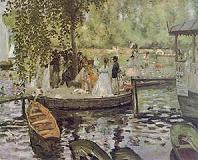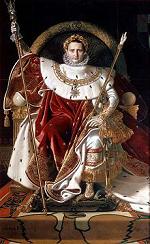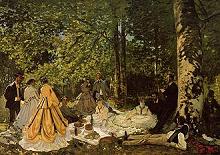 |
| |


Feature Archive
London Views: Spring 2007 and Beyond
| Renoir Landscapes 1865-1883 |
| The Unknown Monet |
| Citizens and Kings: Portraits in the Age of Revolution, 1760-1830 |
| By Diane Apostolos-Cappadona |
|
|

Pierre-Auguste Renoir
Bathing at La Grenouillière
Source: Wikimedia
Walking past the over 60 works displayed in The National Gallery, London, over a span of several grey March days, I was transported into summer gardens, spring festivals, and sunny exotic locales. The almost 20 years' worth of works which were selected for this special exhibition highlight Renoir's artistic development into his own singular perspective - ranging from subject matter to brushwork to color and light - which culminates in what we normally identify as "a Renoir," for example, the beloved Luncheon of the Boating Party at the Phillips Collection.
For specialists the technical quality of some of these exhibited works will prove weaker than others but these are the visions of an emerging young artist trying to find his way through the requirements of the academy and the beginnings of the "new art" of Impressionism. Viewers are offered a unique opportunity to travel with Renoir as he begins to depict "suburban themes" such as Bathing at La Grenouillière (1868-1869) or Monet Painting in his Garden at Argenteuil (1873) and as he starts to see Paris through the new lenses of Impressionist light and color in Les Grandes Boulevards (1875) or Garden in the Rue Cortot, Montmarte (1876). When the artist begins to travel outside of France - to Venice, Naples, and Algiers - we accompany him through the distinctive sunlight and colors, and the commensurate transformations of forms in the Piazza San Marco (1881) and the Arab Festival (1881).
| |
Renoir Landscapes 1865-1883 was organized by The National Gallery, London where it was on view from 21 February through 20 May 2007; the National Gallery of Canada, Ottawa where it is on view from 8 June through 9 September 2007; and the Philadelphia Museum of Art where it will be view from 4 October 2007 through 6 January 2008. Corporate sponsorship for this exhibition is provided by Ernst & Young.
|
|
The smaller, almost dossier in quality and presentation, exhibition at the Royal Academy of Arts The Unknown Monet: Pastels and Drawings provided a new entrée into the world of another well-known Impressionist. This display of some 80 works drawn from international collections spans the length of Claude Monet's artistic career as it argues for a new understanding of this "Impressionist" as a draughtsman, more specifically as a careful and accomplished draughtsman. Sketch books and charcoal drawings combine with pastels to belie the artist's public avowals that preliminary drawing was not part of his artistic process. Rather, the impression which one is left with upon exiting this beautiful exhibition is that the spontaneity characteristic of Impressionism is not a myth or a legend but rather the result of the freedom created from the careful and disciplined tradition of learning how to draw.
This exhibition calls for reconsideration NOT of Monet's mastery of light, color, atmosphere, and "fleeting moments" but of the now clear reality that the tradition of draughtsmanship was the foundation of Impressionism. Exhibited preparatory sketches for his 1860s Normandy landscapes and earlier versions of Déjeuner sur l'herbe lead viewers to see the interconnections between his drawings, pastel "sketches," and paintings. Further, the obvious fusion of colors, tones, and forms found in his pastels of Sainte-Adresse, View Across the Estuary (1868-69) and Waterloo Bridge (ca.1901) correlate to his more well-known London series and eventually his Nymphéas (Water Lilies). His earlier black chalk drawing of the Figure of a Woman (Camille) from ca.1865 provides the visual witness of not simply his skillful draughtsmanship but the clear connection between the tradition of drawing and Impressionism.
| |
The Unknown Monet: Pastels and Drawings was organized by the Sterling and Francine Clark Art Institute, Williamstown, MA, where it will be on view from 24 June through 16 September 2007, in association with the Royal Academy of Arts, London, where it was on view from 17 March to 10 June 2007. Corporate sponsorship for this exhibition has been provided by Bank of America.
|
|

Jean Dominique Ingres
Napoleon
Source: Wikimedia
However as the viewer walks through Citizens and Kings, there is the realization that this is not a study in the history of portraiture or of artistic styles even though the exhibition is divided into eleven sections ostensibly in terms of portraiture that is "formal and official portraits," "portraits of statesmen," and so forth. However this is an exhibition about the history of ideas, specifically of the ideas that wrought the massive societal shifts that the "spin" of the term Age of Reason has so well disguised. Joshua C. Taylor, the former Director of the National Museum of American Art, advised that the arts are sometimes ciphers through which a culture sees itself so that during a time of political or economic turmoil, the arts provide a locus of calm; while during a period of peace and prosperity, the arts conversely present a vision of dynamism and emotional excitement.
So traversing the depictions of political and social power from the outstanding first gallery of this exhibition where the portraits of Popes, Kings, and Emperors dominate to the last galleries where the "every day" people from the artist's sisters in the case of Constantin Hansen to society ladies and family portraits by Joshua Reynolds and Thomas Lawrence people the walls. Although not included in either the wall didactics or the exhibition catalogue, the transformation of styles of dress for both men and women could have been an intriguing approach to "reading" both these portraits and this cultural epoch.
Nevertheless, Citizens and Kings was an enthralling visual presentation of the history of ideas, and an exhibition from which to learn as much about cultural history as about art. As Alan Riding noted in his review in The New York Times, the opening and closing portraits of this exhibition - Napoleon on the Imperial Throne (1806) and Louis-François Bertin (1832) - were both by the masterful French artist Jean Dominique Ingres. While imbuing both men with the dignity they well deserved in their lifetimes - Napoleon as both general and emperor, and Bertin as the influential newspaper editor who was a major player in the 1830 revolution - Ingres made the necessary artistic and societal journey from a painter of the court to a painter of citizenry. The artists and the artworks then stood as witnesses to the societal upheavals and political transformations of the American and French Revolutions, and perhaps as significant the Industrial Revolution which forever transformed the then known world.
| |
Opening after my spring visit to London were two exceptional exhibitions which will remain on view throughout the summer months. The British Library's highly praised exhibition of beautiful, oftentimes rare, manuscripts and books, entitled Sacred: Discover what we share, boasts "the world's greatest collection of Jewish, Christian, and Muslim holy books". The exceptionally informative interactive website for this exhibition can be accessed at http://www.bl.uk/sacred. Sacred remains on view until 23 September 2007.
Meanwhile, the special exhibition The Art of Italy in the Royal Collection: Renaissance and Baroque is on view at the Queen's Gallery, Buckingham Palace, in London through 20 January 2008. Featuring almost 200 rarely seen paintings and drawings, the jewels of this exhibition are the two recently "discovered" paintings by Caravaggio - The Calling of Saints Peter and Andrew and A boy peeling fruit. To learn more about The Art of Italy in the Royal Collection go to http://www.royalcollection.org.uk/default.asp?action=article&ID=387
|
|
Past Articles
2007
Modernism: Designing a New World, 1914-1939, by K. Kimberly King
Italian Women Artists from Renaissance to Baroque, by Diane Apostolos-Cappadona
What Jasper Johns "Can't Avoid Saying", by K. Kimberly King
Holy Image/Hallowed Ground: Icons from Sinai, by Diane Apostolos-Cappadona
2006
Prayers and Portraits: Unfolding the Netherlandish Diptych, by Diane Apostolos-Cappadona
Stop, See, and Soar:
"Société Anonyme", by K. Kimberly King
Constable's Great Landscapes, by Joseph Phelan
Editorial: Save Studio 60 (from needing to be saved), by John Malyon
Far From Heaven: Anselm Kiefer at the Hirshorn, by Joseph Phelan
Henri Rousseau: Self-Taught in Paris, by K. Kimberly King
Klee, Hitler and America, by Joseph Phelan
Anyone For Venice?, by Joseph Phelan
The Legends of Leonardo, by Joseph Phelan
Hey, "Dada"-Dude, Where's the Rest of Me?, by K. Kimberly King
Cézanne in Provence, by Joseph Phelan
Angels in America: Fra Angelico in New York, by Joseph Phelan
2005
Notes on New York (NoNY), by Joseph Phelan
The Greatest Painting in Britain
French Drawings and Their Passionate Collectors, by Joseph Phelan
Missing the Picture: Desperate Housewives Do Art History, by Joseph Phelan
The Salvador Dalí Show, by Joseph Phelan
2004
Boston Marathon, by Joseph Phelan
Philadelphia is for Art Lovers, by Joseph Phelan
Featured on the Web: Understanding Islamic Art and its Influence, by Joseph Phelan
Independence Day: Sanford R. Gifford and the Hudson River School, by Joseph Phelan
The "Look" of Mel Gibson's The Passion of the Christ, by Joseph Phelan
The Importance of Being Odd: Nerdrum's Challenge to Modernism, by Paul A. Cantor
2003
Advent Calendar 2003, narrated by Joseph Phelan
If Paintings Could Talk: Paul Johnson's Art: A New History, by Joseph Phelan
Mad Max [Max Beckmann], by Joseph Phelan
Marsden Hartley: The Return of the Native, by Joseph Phelan
Jean-Antoine Houdon: Sculptor of the Enlightenment, by Joseph Phelan
Frederic Remington's Nocturnes, by Joseph Phelan
Magnificenza! Titian and Michelangelo, Manet and Velazquez, by Joseph Phelan
Masterful Leonardo and Graphic Dürer, by Joseph Phelan
Favorite Online Art Museum Features, by Joseph Phelan
Studies for Masterpieces, by John Malyon
2002
Portrait of the Artist as a Serial Killer, by Joseph Phelan
Renoir's Travelling, Bonnard's "At Home, by Joseph Phelan
The Philosopher as Hero: Raphael's The School of Athens, by Joseph Phelan
The Greatest Works of Art of Western Civilization
Celebrating Heroes; Celebrating Benjamin West, by Joseph Phelan
Chasing the Red Deer into the American Sublime (Education and the Art Museum, Part II), by Joseph Phelan
Planning Your Summer Vacation, by Joseph Phelan
Education and the Art Museum, Part I, by Joseph Phelan
Unsung Griots of American Painting, by Joseph Phelan
The British Museum COMPASS Project, interview by Joseph Phelan
Robert Hughes, Time Magazine Art Critic: Biography and Writings
2001
Software review: Le Louvre: The Virtual Visit on DVD-ROM, by Joseph Phelan
Tragedy and Triumph at Arles: Van Gogh and Gauguin, by Joseph Phelan
Her Last Bow: Sister Wendy in America, by Joseph Phelan
Love, Death and Resurrection: The Paintings of Stanley Spencer, by Joseph Phelan
Who is Rodin's Thinker?, by Joseph Phelan
Celebrations North and South, by Joseph Phelan
Rubens and his Age, by Joseph Phelan
Great Reproductions of Great Paintings
The Passion of Christ, by Joseph Phelan
Edouard Manet: Public Spaces, Private Dreams, by Joseph Phelan
Henry Moore and the British Museum: The Great Conversation, by Joseph Phelan
2000
Notorious Portraits, Part II, by John Malyon
Notorious Portraits, Part I, by John Malyon
The Other Michelangelo, by Joseph Phelan
The Art of Drawing, by Joseph Phelan
Poussin and the Heroic Landscape, by Joseph Phelan
Great Art Museums Online, by Joseph Phelan
Venetian Painting and the Rise of Landscape, by Joseph Phelan
Forbidden Visions: Mythology in Art, by Joseph Phelan
Themes in Art: The Passion of Christ, by Joseph Phelan
Web site review: Christus Rex
Web site review: National Gallery of Art, Washington, D.C., by Joseph Phelan
Online exhibit review: Inuit Art: The World Around Me, by John Malyon
Poll: Who is Producing the Most Interesting Art Today? (Results)
Poll: Who is Producing the Most Interesting Art Today? (Part II)
1999
Poll: Who is Producing the Most Interesting Art Today? (Part I)
Spotlight on The Louvre Museum
Spotlight on Impressionism
Spotlight on Optical Art
Spotlight on Animals in Art
Spotlight on Surrealism
Spotlight on Sculpture
Spotlight on Women in the Arts
Spotlight on The Golden Age of Illustration
Spotlight on Vincent van Gogh
Spotlight on Great Art
|


